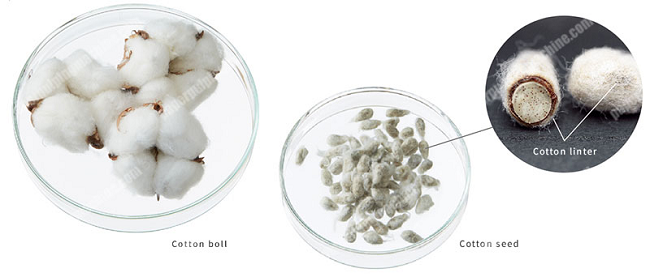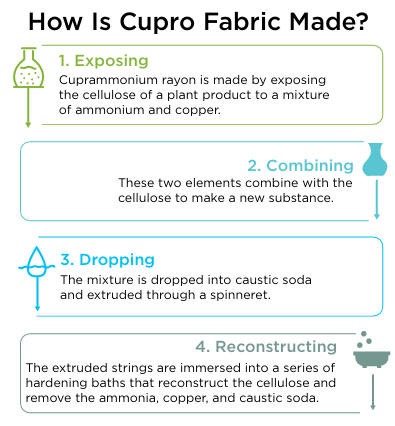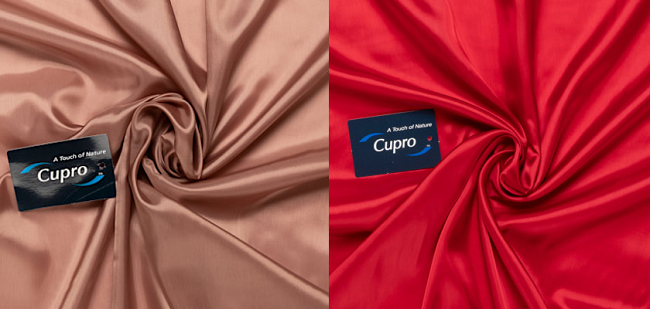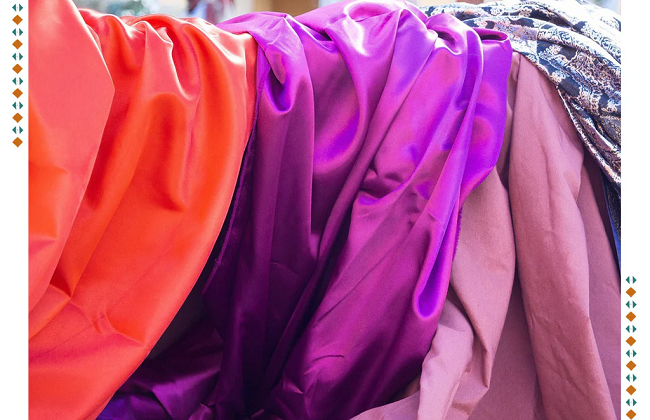Cupro, a semi-synthetic fiber, is derived from cotton waste, primarily from linters—small, protruding cottonseed segments that are too small to spin—into yarn. Because of the application of the copper and ammonia solution, this regenerated cellulose fiber is known as cuprammonium rayon, or cupro for short.

Production process
The production process of cupro fiber is termed the Cuprammonium process. This process can be described in three steps, like raw material collection, creating spunable solutions, and spinning through a spinneret.
Raw material collection:
Firstly, we have to collect cotton waste and then transform it into small fiber pieces. These linters will be the base fiber used to make the fabric.
Making a spunable solution:
Because linters are too tiny, they will be soaked in a chemical solution instead. The fibers will be exposed to copper and ammonia. After that, they will be combined with caustic soda to create a fresh substance.
Spinning through spinneret:
It is now time to spin the new material into a spinneret. This neutralizes the fibers and washes away the ammonia, copper, and caustic soda. The fibers will then be chilled in order to form longer filaments.

Characteristics:
Cupro is called ‘vegan silk’, silk-like fabric due to its soft texture. Here are some of the most common characteristics of cupro.
Soft and drapes well:
This fabric is lightweight, cozy, and silky. It’s quite stretchy and thin as well. The sheerness of it makes for a nice drape.That’s why cupro fabric is a good choice for thin clothing and form-fitting cupro dresses.
Not that breathable:
Cotton is the base material for this fabric. So it has the same qualities as cotton fiber. However, due to the chemicals utilized, cupro cloth is less breathable than cotton. It also cannot withstand high temperatures.
If you expose this fabric to temperatures exceeding 180 degrees, it will ignite. It will also leave a large amount of copper residue.
Moisture-wicking and anti-bacterial:
Cupro cloth has a high moisture absorption rate. It’s also an antibacterial and hypoallergenic fabric. It drys quickly. As a result, it’s an ideal cloth for sportswear. A few examples include cupro T-shirts, sports bras, and tank tops.
Fair durability:
Cupro is not as strong as other rayons. However, it is still regarded as a durable cloth. It is stronger than viscose and silk. And, because silk is so expensive, many people prefer cupro as a more lasting and attractive alternative.
Sustainability concern:
Unfortunately, we cannot give you an easily understood yes or no answer. So, let’s start with the sustainability advantages and disadvantages of cupro.
The eco-friendly and ethical pros of cupro fabric:
- Vegan – No silkworms are frozen to death or boiled alive to produce cupro cloth.
- Biodegradable – In contrast to polyester and most synthetic textiles, cupro clothing will not remain in landfills for decades.
- Byproduct of the cotton industry – Cotton production is extremely harmful to the environment, using pesticides and consuming large amounts of water. However, no further supplies or energy are required to grow its linter.
- Reduced waste – All that linter would otherwise be thrown.
- Machine-washable – Dry-cleaning is typically suggested for delicate silk items, but it uses hazardous chemicals that are damaging to both humans and the environment. However, you can put your cupro clothing in the washer (as long as you use cold water).
The cons of cupro fabric:
The main issues with cupro arise from its chemical-intensive manufacturing process, which includes copper, ammonia, and caustic soda.

- Polluting chemicals and toxic substances – When cupro fabric is not created in a closed-loop system (meaning most of the water is reused and the rest is carefully disposed of), the chemicals harm local water sources and even groundwater. That is dangerous for both local fauna and communities!
- Harmful for workers – Workers who are continuously exposed to these chemicals may also be at risk.
So, is cupro fabric sustainable?
It’s not ideal, but we believe Cupro is a fairly sustainable fabric as long as it’s manufactured using a closed-loop system and workers are kept safe.
The reasons why fashion firms who use cupro should be transparent and have a traceable supply chain (as should any company that claims to be sustainable). Using authentic Bemberg™ Cupro ensures a consistent outcome.

Cupro is a more ethical option than typical silk because it is cruelty-free and vegan. Furthermore, it is more ecologically friendly than most vegan alternatives that use plastic-derived synthetic materials.
Uses
Cupro fabric is used for a wide variety of apparel.
Formal clothing
Cupro cloth is significantly cheaper than silk. As a result, many people consider this a ‘affordable luxury.’ Cupro is commonly used in formal gowns and men’s suit linings. Cupro slacks are also quite frequent.
Sportswear
Today, most cupro fabrics are blended with other fibers. This fabric is frequently mixed with elastane and spandex to increase stretch. This mixed fabric allows you to create cupro yoga pants, sweatpants, and other stretchy athleisure apparel.
Lingerie
Cupro is fairly sheer in nature. Clothing constructed of cupro is body-hugging. You can also use cupro fabric to produce intimate clothing. It is also utilized in nightwear, including cupro pajamas, nightgowns, and dressing gowns.
Fashion Accessories
This fabric is also suitable for making fashion accessories like as scarves and shawls. Fashion add-ons made from cupro are versatile.
















